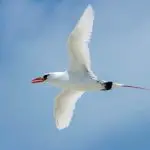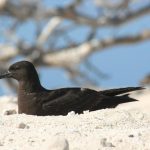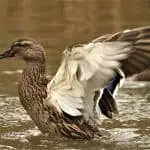Common Name: Bufflehead
Scientific Name: Bucephala albeola| Size | Diet | Range in Hawaii | Status in Hawaii |
|---|---|---|---|
| 13 in. - 16 in. | small aquatic invertebrates and crustaceans | Oahu, Maui, and the Big Island | Least Concern |
Facts about the Bufflehead (Bucephala albeola) unfold as we explore its intriguing presence in the captivating landscapes of Hawaii. Predominantly known for its distinctive characteristics and primarily found in North America, including Canada and the United States, this remarkable duck species has also made notable appearances in the picturesque islands of Hawaii.
In this article, we will uncover the fascinating presence of the Bufflehead in Hawaii, delve into its remarkable adaptations, and appreciate the enchanting qualities that make it a cherished gem within the realm of avian biodiversity.
Bufflehead
Appearance
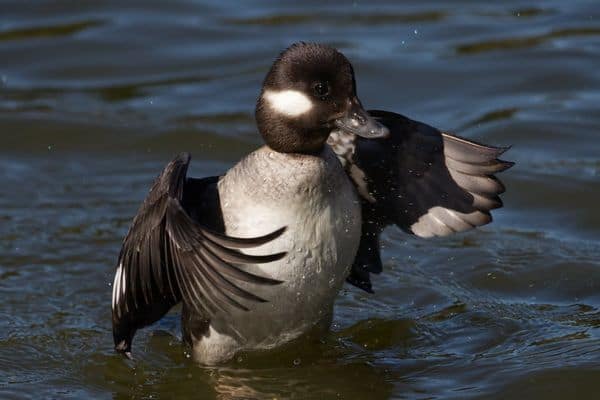
The Bufflehead is a small and visually striking duck species. The male Bufflehead boasts a bold and eye-catching appearance with its contrasting black and white plumage. Its head is glossy greenish-black, while the back and wings are predominantly black.
The white patches on its face, flanks, and underbelly add a touch of elegance. In contrast, the female Bufflehead features a more subdued yet beautiful appearance, with a grayish-brown body and a distinct white patch on the cheek.
On average, Buffleheads measure around 13-16 inches (33-41 centimeters) in length, making them a compact and captivating species within the waterfowl family.
Diet
The diet of the Bufflehead primarily consists of small aquatic invertebrates and crustaceans. These agile divers feed on a variety of food sources such as insects, larvae, small fish, mollusks, and aquatic plants.
They are known for their ability to dive underwater in search of their prey, using their sharp bills to capture their food with precision. Buffleheads are adept at foraging in both freshwater and marine environments, showcasing their adaptability and resourcefulness when it comes to securing their nourishment.
Nesting
Buffleheads exhibit fascinating nesting behaviors as they create their homes in tree cavities, particularly those made by woodpeckers or natural hollows near water bodies. The female Bufflehead selects a suitable nesting site and lines the cavity with soft materials such as down feathers and plant matter for insulation and comfort.
She lays a clutch of around 8 to 10 creamy white eggs, carefully tending to them during the incubation period, which lasts approximately 28 days. Once the eggs hatch, the female leads her adorable ducklings to the water within a day or two, where they embark on their journey of growth and exploration under her watchful care.
The Bufflehead’s nesting habits exemplify their adaptability to utilizing natural crevices for shelter, ensuring the safety and development of their offspring.
Behavior
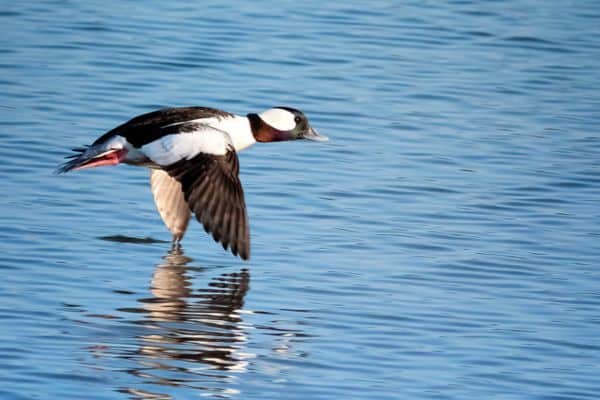
Buffleheads demonstrate a diverse range of behaviors that make them captivating to observe. These small diving ducks showcase remarkable agility in both swimming and diving.
With swift plunges beneath the water’s surface, they utilize their wings and feet to propel themselves in search of prey. Buffleheads often gather in small groups or pairs, engaging in synchronized diving that presents a mesmerizing spectacle.
During courtship displays, the male Bufflehead performs intricate head movements while emitting distinctive calls. These sociable birds frequently congregate with other waterfowl species, establishing strong monogamous bonds during the breeding season.
Pairs typically remain together for a single breeding cycle, showcasing their commitment to partnership. Buffleheads demonstrate impressive aerial skills as adept flyers, maneuvering swiftly and gracefully through wooded areas with their rapid wingbeats.
Their vocal repertoire includes soft, high-pitched calls, serving as a means of communication within their flock and for territorial purposes.
Habitat
Buffleheads occupy a wide array of habitats throughout North America, exemplifying their adaptability and versatility. These captivating duck species can be observed in diverse freshwater environments, including serene lakes, tranquil ponds, and vibrant marshes.
Moreover, they are often found in coastal areas such as estuaries, bays, and sheltered coastal lagoons. During the breeding season, Buffleheads actively seek out nesting sites near water bodies, demonstrating their preference for habitats that offer suitable shelter and resources.
These nesting sites often include tree cavities formed by woodpeckers or natural hollows. Buffleheads can thrive in both large and small bodies of water, including rivers, reservoirs, and even sheltered coastal regions.
Their chosen habitats provide an abundant food supply, consisting of small aquatic invertebrates, crustaceans, insects, and various aquatic plant matter. Buffleheads’ remarkable ability to dive and swim underwater allows them to forage and capture prey with remarkable precision.
Range
The Bufflehead, which is primarily a migratory species found in North America, including Canada and the United States, has been observed in Hawaii. Specifically, they have been documented in the main islands of Oahu, Maui, and the Big Island (Hawaii Island).
While not considered permanent residents, these small diving ducks can be spotted in wetlands, ponds, and coastal areas of these islands during their migratory journeys. Their presence in Hawaii adds to the avian diversity of these regions and provides opportunities for birdwatchers to catch glimpses of these remarkable waterfowl.
Conservation Status
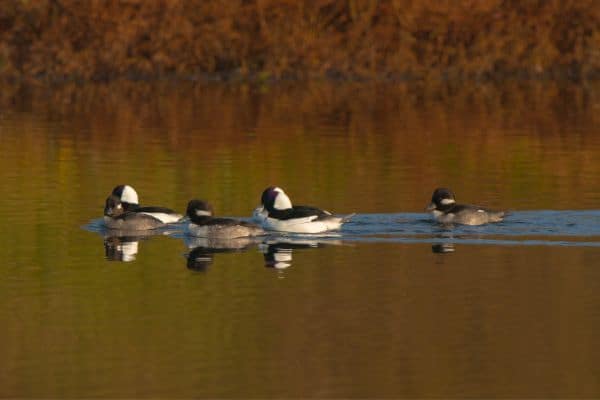
The Bufflehead is categorized as a species of “Least Concern” on the IUCN Red List. The global assessment considers the overall population size and distribution of the Bufflehead across its range, which includes North America, where it is more commonly found.
While specific conservation assessments for the Bufflehead in Hawaii are not provided by the IUCN, the species’ overall status indicates that it is not currently facing significant threats or experiencing a population decline that would warrant higher conservation concern.
Interesting Facts
1. Striking Plumage
Male Buffleheads have striking black and white plumage, with a glossy greenish-black head, black back, and a large white patch on the back of their head. Females, on the other hand, feature a grayish-brown body with a distinct white cheek patch.
2. They are mighty Divers
Buffleheads are exceptional divers, capable of diving to impressive depths to forage for food. They can plunge underwater and stay submerged for up to 12.5 seconds, using their wings and feet to propel themselves.
3. Acrobatic Flight
These ducks are known for their agile and acrobatic flight. They can swiftly maneuver through trees and dense vegetation with rapid wingbeats, displaying remarkable aerial skills.
4. Monogamous Breeding Pairs
Buffleheads form monogamous breeding pairs during the breeding season. They engage in elaborate courtship displays, where the male performs head movements and distinctive calls to attract the female.
5. Moniker of “Bufflehead”
The name “Bufflehead” refers to the male’s large, puffy white head, which resembles a buffalo’s head. The word “buffalo” transformed into “buffle” and combined with “head” to form their unique name.
Frequently Asked Questions
1. Are Buffleheads social birds?
Buffleheads are generally social birds and can be observed in small groups or flocks during winter. However, they can also be seen in pairs or individually during the breeding season.
2. How long do they live?
The average lifespan of a Bufflehead is around 5 to 10 years in the wild, although some individuals have been known to live longer.
3. Are Buffleheads vocal?
Buffleheads are relatively quiet compared to other duck species. However, during courtship displays, the male may emit low, nasal calls.
4. Can Buffleheads hybridize with other duck species?
While rare, hybridization between Buffleheads and other duck species, such as Goldeneyes, has been documented in some instances.

